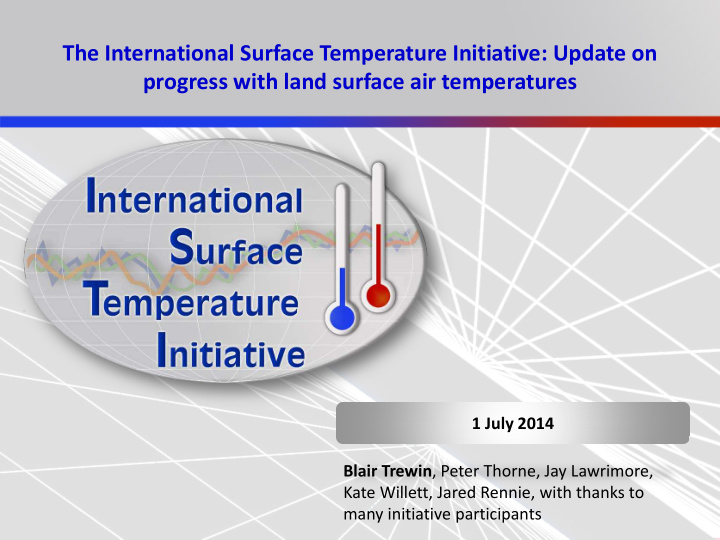



The International Surface Temperature Initiative: Update on progress with land surface air temperatures 1 July 2014 Blair Trewin , Peter Thorne, Jay Lawrimore, Kate Willett, Jared Rennie, with thanks to many initiative participants
History and purpose of ISTI • ISTI was created following a CCl resolution in 2010 • Goal is to have an open, transparent and traceable data set with maximum global coverage • Aiming for data at a range of timescales (monthly, daily, sub-daily) • Governance through a steering committee and subject-matter working groups • Not a formal WMO program, but has considerable involvement from NMHSs, as well as other institutions, and experts from other relevant fields (e.g. statistics, metrology)
The real world observing system is not the lab … we are not dealing with 10 -N K Michael de Podesta’s ‘Instrument of real beauty’ Image courtesy Michael de Podesta, NPL
It's not, in general, these either … US Climate Reference Network website
It's more like these … Huge range of instrument types, siting exposures etc. regionally, nationally and globally with many changes over time. Various sources online
Inhomogeneities: annual mean minimum temperature at Reno, Nevada, USA (Matt Menne and Claude Williams, NOAA National Climatic Data Center)
The long list of issues to be considered … • Station moves • Instrument changes • Observer changes • Automation • Time of observation biases • Microclimate exposure changes • Urbanization • And so on and so forth …
Underlying which are two absolutely fundamental issues … • A lack of traceability to absolute or relative standards for most, if not all, of the historical records • A lack of adequate documentation of the (ubiquitous) changes sufficient to characterize on a station by station basis in an absolute sense their changing measurement characteristics.
ISTI: Creating a framework to enable advances • The International Surface Temperature Initiative can put in place certain structures to enable science advances 1. Basic environmental data provision 2. Creation of independent means to benchmark and assess 3. User advice • The rest is down to the global science community ….
Step 1: Data rescue and provision Jay Lawrimore, Jared Rennie and Peter Thorne (2013) Responding to the Need for Better Global Temperature Data, EOS, 94 (6), 61–62 DOI: 10.1002/2013EO060002
Stage 0 / Stage 1 Overview and Metadata Stage 0: Original observation Scanned Images of paper record (PDF / JPG) Stage 0 Not always available Conversely, a lot of data only exist on paper (or as scanned images) – still a great need for data rescue Stage 1: Native keyed format. Databank policy encourages data be provided in its Stage 1 rawest form; that closest to the measurements that were first reported by the observer. • Ideally no quality control or homogenization should be applied prior to submission Other Requirements • Any time scale (monthly / daily / hourly) • Metadata: latitude, longitude, elevation, name • Other metadata: ID, country of origin, instrumentation
Data Provenance Tracking Flags • Data source for Stage 0 Files – NCDC, JMA, BOM Data source for Stage 1 Files • – NCDC, NMA’s, other international organizations • Type of data sent by source – Raw, quality controlled, bias corrected • Mode of Digitization – SourceCorp, CDMP, Local Originator • Mode of converting hourly data into daily data – Main standard synoptic times, intermediate synoptic times, other • Method of converting daily data into monthly summaries – How many days used to calculate monthly average
Stage 3 merging program • Take all monthly sources and combine them into one complete global dataset • Metadata matching and data equivalence criteria • Code is readable, portable, and modular – need an automated method due to large number of stations • Recommended product, along with several variants to characterize uncertainty • Results placed on FTP – ftp://ftp.ncdc.noaa.gov/pub/data/globaldatabank/monthly/stage3
Source hierarchy • 58 sources total – 33 daily (monthly summaries) – 25 monthly • Certain sources need to be given a higher preference, so that no valuable information is lost • ISTI has developed a set of criteria that dictates the hierarchy for the recommended merge • In addition, some grossly overlapping sources aren’t considered, to avoid excess duplication
How does ISTI coverage compare with other global data sets?
Databank updates • Databank v1 release occurred at 14Z on June 30 th – hooray! • Current version of databank is monthly only – daily version to be released at later date • Monthly updates based upon GHCN-D and CLIMATs will occur • Every 6 months to year a total rerun and version increment will occur, adding in new sources accrued. – 10 in queue – please help us increase that number!
Homogenisation and benchmarking • A major part of ISTI is providing a platform for benchmarking homogenisation methods. • With real world data we do not have the luxury of knowing the truth – we CANNOT measure performance of a specific method or closeness to real world truth of any one data- product. • We CAN focus on performance of underlying algorithms (AKA software testing) - consistent synthetic test cases, simulating real world noise, variability and spatial correlations potentially enable us to do this.
Benchmarks • Global benchmarks that mirror the databank holdings will be made available in 2 nd half of 2014 • Benchmarks will be available for c.2 years for analysis • Then unveiled and different algorithms assessed.
ISTI – potential to be a basis for global and regional data products?
How countries can contribute • Making data (especially daily data) available to ISTI • Participating in data rescue activities • Participating in the benchmarking project To make arrangements for data submissions (in any reasonable format), contact data.submission@surfacetemperatures.org
Questions and Answers www.surfacetemperatures.org Bull. Amer. Met. Soc. doi: 10.1175/2011BAMS3124.1 https://www2.image.ucar.edu/event/summerprog.surfacetemps Peter.thorne@nersc.no Data.submission@surfacetemperatures.org
Recommend
More recommend